Attached files
| file | filename |
|---|---|
| 8-K - FORM 8-K - VALERO ENERGY CORP/TX | d878186d8k.htm |
 Investor
Presentation February 2015
Exhibit 99.01 |
 Statements
contained in this presentation that state the company’s or management’s
expectations or predictions of the future are forward– looking statements intended
to be covered by the safe harbor provisions of the Securities Act of 1933 and the
Securities Exchange Act of 1934. The words “believe,”
“expect,”
“should,”
“estimates,”
“intend,”
and other similar expressions identify forward–looking
statements. It is important to note that actual results could differ
materially from those projected in such forward–looking statements.
For more information concerning factors that could cause actual
results to differ from those expressed or forecasted, see Valero’s
annual reports on Form 10-K and quarterly reports on Form 10-Q, filed
with the Securities and Exchange Commission, and available on
Valero’s website at www.valero.com.
2
Safe Harbor Statement |
 3
Who We Are
World’s Largest Independent Refiner
•
15 refineries, 2.9 million barrels per day (BPD) of high-complexity throughput
capacity •
Greater
than
70%
of
refining
capacity
located
in
U.S.
Gulf
Coast
and
Mid-Continent
•
Approximately 10,000 employees
Large Logistics Infrastructure with Focus on Growth
•
General partner and majority owner of Valero Energy Partners LP (NYSE: VLP), a
growth-oriented, fee-based master limited partnership (MLP)
•
Significant inventory of logistics assets within Valero
Wholesale Fuels Marketer
•
Approximately 7,400 marketing sites in U.S., Canada, United Kingdom, and Ireland
•
Brands include Valero, Ultramar, Texaco, Shamrock, Diamond Shamrock, and Beacon
One of North America’s Largest Renewable Fuels Producers
•
11 corn ethanol plants, 1.3 billion gallons per year (85,000 BPD) production capacity
•
Operator
and
50%
owner
of
Diamond
Green
Diesel
joint
venture
–
10,500
BPD
renewable diesel production capacity |
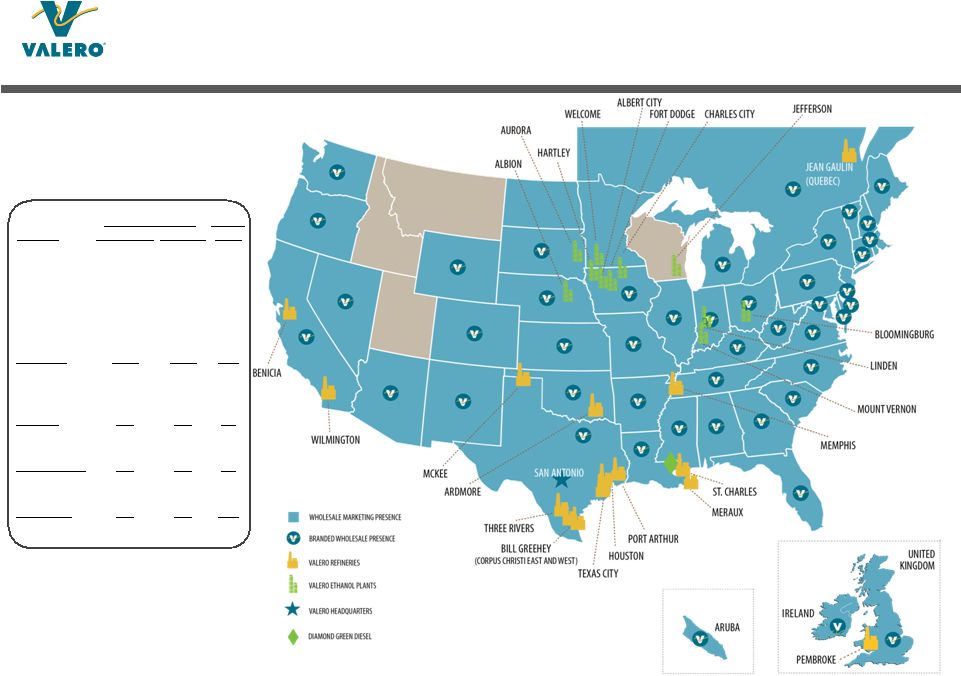 4
Assets Concentrated in
Advantaged Locations
Refinery
Capacities (MBPD)
Nelson
Index
Throughput
Crude Oil
Corpus Christi
325
205
19.9
Houston
175
90
15.4
Meraux
135
125
9.7
Port Arthur
375
335
12.4
St. Charles
290
215
16.0
Texas City
260
225
11.1
Three Rivers
100
89
13.2
Gulf Coast
1,660
1,284
14.0
Ardmore
90
86
12.1
McKee
180
168
9.5
Memphis
195
180
7.9
Mid-Con
465
434
9.3
Pembroke
270
210
10.1
Quebec City
235
230
7.7
North Atlantic
505
440
8.9
Benicia
170
145
16.1
Wilmington
135
85
15.9
West Coast
305
230
16.0
Total or Avg.
2,935
2,388
12.4 |
 Strategy to
Enhance Stockholder Returns Operations
Excellence
Capital Returns to
Stockholders
Disciplined Capital
Investments
Unlocking Asset
Value
•
Demonstrate commitment to safe and reliable operations
•
Continuously improve our top-tier operating performance
•
Optimize margins with refining system’s feedstock and product
markets flexibility
•
Disciplined capital allocation
•
Seek to increase cash returns through dividend growth
•
Use stock buybacks to reduce shares outstanding and concentrate
future value per share
•
Rigor in capital projects and M&A selection and execution
•
Invest to grow logistics assets and reduce feedstock costs
•
Evaluate investments to upgrade natural gas and natural gas liquids
•
Opportunistically invest in ethanol to maintain high returns
•
Grow Valero Energy Partners LP and realize value for Valero
•
Execute accelerated dropdown strategy and evaluate other
potential MLP-able earnings streams
•
Previously unlocked value in retail business via 2013 spinoff to
stockholders
5 |
 6
Key Market Trends
U.S. and Canadian crude oil, natural gas, and natural gas liquids
(NGLs) production growth is providing cost advantages to
North American refiners
-
Lower crude prices may temporarily constrain production growth rate
Location-advantaged refiners in U.S. Gulf Coast, Mid-Continent,
and Canada benefit from resource advantages and/or export
opportunities
Global refined products demand growth is expected to continue
-
Expect lower prices to consumers will drive product demand growth
|
 Production
Growth Provides Resource Advantage to North American Refiners
Source: DOE (for 2014, data through November)
Source: DOE (for 2014, data through November)
7 |
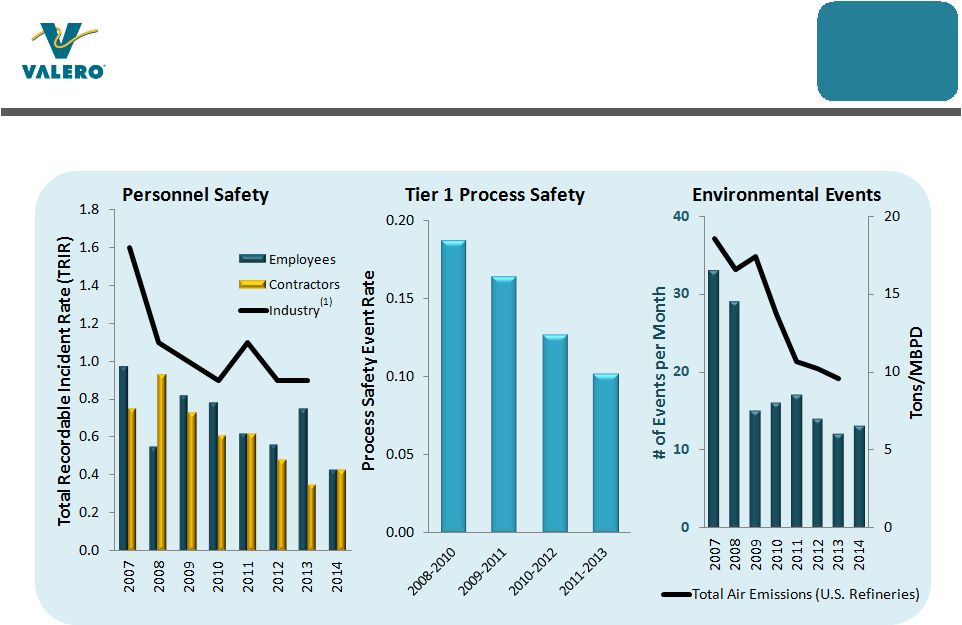 8
Persistent Focus Drives Results in Safety,
Environmental, and Regulatory Compliance
(1)Source: U.S. Bureau of Labor Statistics.
All 2014 values are estimates.
Statistics are for Refining only.
Operations
Excellence |
 9
Top-Tier Operating Performance through
Continuous Improvements
Source:
Solomon
Associates
and
Valero
Energy,
includes
Pembroke
and
Meraux
2012
2010
2008
•
Reliability drives safe and
profitable operations
Seven of our refineries are first
quartile in mechanical availability
•
Initiated new reliability programs
beginning mid-2000s
•
Significant gains made in
operations benchmarks since
2008
•
Personnel committed to
excellence |
 Sustained
high availability and favorable margin environment enable higher capacity utilization
rates 10
Reliability Programs and Commercial
Optimization Drive Higher Utilization Rates
System-wide
mechanical
availability near
1
st
Quartile
since
2011 |
 11
Optimizing Margins with Feedstock Flexibility
in Our Complex Refinery System
•
Capability to adjust
feedstocks and optimize
margins as crude price
environment shifts among
grades: light, medium,
heavy, sweet, sour
•
Focus on optimization
activities
•
Expect additional light crude
flexibility with completion
of topper units in progress
Range of Flexibility in Valero’s Gulf Coast
Region Quarterly Feedstock Mix 2010-2014 |
 •
Approximately half of benefits visible in
margin capture rate increase of >4%
and balance of benefits in 100 MBPD
throughput volume increase from
feedstocks and new gas plant
•
Benefits visible in U.S. Gulf Coast
region reported results improvement
from 4Q12 to 3Q14
(1)
•
120 MBPD of combined new capacity
successfully started end of 2012 and
mid-2013
•
Designed to produce high-quality
distillates from low-quality feedstocks
and natural gas
Port Arthur and St. Charles Hydrocrackers
Performing Better Than Expected
12
(1) See Appendix for details and assumptions
•
Realized annual EBITDA estimated at
$800 million for trailing 4-quarters
3Q14
•
Compares to $780 million implied by
disclosed guidance model
(1) |
 Disciplined
Capital Allocation Framework Emphasizes Stockholders
Dividend Growth
•
Focus on sustainability
•
Increase competition
for cash flow versus
reinvestments (growth
capex and acquisitions)
Sustaining Capex
•
Estimate $1.5 billion or
lower annual “stay-in-
business”
spend
•
Key to safe and
reliable operations
Debt and Cash
•
Maintain investment
grade credit rating
•
Target 20% to 30%
debt-to-cap ratio
(1)
Stock Buybacks
•
Flexibility to return
cash, reduce share
count, and manage
capital employed
•
Increase competition
versus reinvestments
Growth Capex
•
Prioritize higher-value,
higher-growth, faster-
payback opportunities
that enhance future
returns
Acquisitions
•
Evaluate accretion
versus stock buybacks
•
Enhance future
returns
“Non-Discretionary”
“Discretionary”
13
Capital
Returns to
Stockholders
(1) Debt-to-cap ratio based on total debt reduced by $2 billion cash balance,
excluding VLP debt and equity |
 14
Increasing Focus on Dividends and Stock
Buybacks
•
Increased dividend by 45% in
1Q15 versus 4Q14
•
Regular dividend increases over
last three years
•
Accelerated stock buybacks in
2013 and 2014
•
Approximately $1.5 billion of
stock repurchase authorization at
end of 4Q14
Targeting >50% total payout ratio of
earnings in 2015 via dividends and
stock buybacks
*2015 through Feb 20 |
 15
Advancing Growth Investments While
Managing Capital Spending Lower
(1) Excludes estimated placeholder for methanol project of $150 million in 2015 and $300
million in 2016 as evaluation remains in progress Disciplined
Capital
Investment
(1)
•
Focus on logistics growth after 2015 spending to complete crude toppers
•
Expect nearly all logistics growth investments to be eligible for dropdown into VLP
|
    Pipelines
•
Completed tie-in to pipeline in Childress, TX and secured incremental
40 to 50 MBPD Midland-priced crude as substitute for Cushing-priced
crude primarily at the McKee refinery
•
Expect Diamond Pipeline to supply Memphis refinery via Cushing and
start up in 1H17 or earlier
Tanks, Docks, and Vessels
•
Tanks and vessels to supply crude to Quebec City refinery post-Enbridge
Line 9B reversal expected in 2Q15
•
Corpus Christi dock commissioned in 3Q14; completion of tanks for
crude exports expected in 1Q15
16
Logistics Investments Enhance Valero’s
Feedstock Flexibility and Export Capability
Rail
•
Purchased 5,320 CPC-1232 railcars; received 4,078 through Jan 2015
•
Expect new railcars to serve long-term needs in ethanol and asphalt
•
Crude unloading facilities at Quebec City, St. Charles, and Port
Arthur
•
Benicia crude unloading facility undergoing permitting process |
 Crude Topper
Investments Very Attractive 17
Estimate $500 million annual EBITDA for combined projects in 2014 price environment
•
160 MBPD new topping capacity
designed to process up to 50 API
domestic sweet crude
Lowers feedstock cost by
generating 55 MBPD low sulfur
resid
Increases net throughput
capacity by 105 MBPD
•
Expect startup in 1H16
•
Expect 50% IRR on 2014 prices,
>25% IRR with Brent and LLS even
•
Corpus Christi: Estimated $350 MM
capex for 70 MBPD capacity
•
Houston: Estimated $400 MM
capex for 90 MBPD capacity
Incremental Volume
(MBPD)
Feeds
Eagle Ford crude
160
Low sulfur atmos resid
(55)
Products
LPG
3.3
Propylene
1.3
BTX
0.4
Naphtha (at export prices)
40
Gasoline
12
Jet
39
Diesel
13
Resid
(3)
Combined Projects Estimates
Total investment
(1)
$750 MM
Annual EBITDA contribution
(2)
$500 MM
Unlevered IRR on total spend
(2)
50%
See Appendix for assumptions.
(1)
Excluding interest and overhead allocation
(2)
Estimates based on 2014 full year average prices; EBITDA = operating income before
deduction for depreciation and amortization expense |
 Key Natural
Gas and NGLs Upgrading Investments
18
Hydrocracker
Expansions
Evaluating
Methanol Plant at
St. Charles
Evaluating Houston
Alkylation Unit
•
1.6
–
1.7
million
tonnes
per
year
production
(36
–
38
MBPD)
•
Leverages existing assets to reduce capital requirement
compared to grassroots facility
•
Continuing to evaluate capital costs and project economics
•
Expect investment decision in 2Q15; startup in 2018 if approved
•
12.5 MBPD capacity
•
Upgrades low-cost NGLs to premium-priced alkylate
•
Continuing to evaluate capital costs and project economics
•
Expect investment decision in 2015; startup in 2017 if approved
•
Increase distillate yield partially from hydrogen via natural gas
•
Completed Meraux’s 20 MBPD capacity expansion in 4Q14;
expect approximately $90 million annual EBITDA contribution
at 2014
(1)
prices on total investment of approx. $260 million
•
30 MBPD total capacity addition at St. Charles and Port Arthur
in progress; expect startup in 2H15
(1) 2014 full year average prices; see project details in Appendix
|
 19
Ethanol Investments Have Performed Well
Note: See Appendix for reconciliation of EBITDA to GAAP results.
Outstanding
Cash
Generation
Excellent
Acquisitions
Competitive
Advantages
•
11 plants acquired between
2Q09 and 1Q14 for $794MM,
less than 35% of replacement
value
•
1.3 billion gallons total
annual production
•
Scale and location in corn
belt
•
Operational best practices
transferred from refining
•
Low capital investment
•
$2.2 billion cumulative
EBITDA generated since
acquisitions
•
$161 million cumulative
capex excluding acquisition
costs |
 20
Our Sponsored MLP
Valero Energy Partners (NYSE: VLP)
Growth-oriented
logistics MLP with
100% fee-based
revenues
•
Valero owns entire 2% general partner interest, all incentive
distribution rights, and 68.6% LP interest
•
High-quality assets integrated with Valero’s refining system
•
Primary vehicle to grow Valero’s midstream investments
•
Provides access to lower cost capital
Unlocking
Asset Value |
 21
Estimated EBITDA from Inventory of Eligible MLP
Assets Total Approximately $900 Million
(1) Includes assets that have other joint venture or minority interests.
Pipelines
(1)
•
Over 1,200 miles of active pipelines
•
Expect start-up of 440-mile Diamond Pipeline from Cushing to Memphis refinery in
1H17
Racks, Terminals, and Storage
(1)
•
Over 72 million barrels of active shell capacity for crude and products
•
139 truck rack bays
Rail
•
Three crude unloading facilities with estimated total capacity of 150 MBPD
•
Purchased CPC-1232 railcars expected to serve long-term needs in ethanol and
asphalt
Marine
(1)
•
51 docks
•
Two Panamax class vessels
Fuels Distribution
•
Evaluating qualifying volumes and commercial structure as potential drop-down
candidate
Expect $1 billion of drop-down transactions to VLP in 2015 |
 22
We Believe Valero Is an Excellent Investment
•
Majority of capacity located in U.S. Gulf Coast and Mid-
Continent with access to cost-advantaged crude, natural gas,
NGLs, and corn
•
Proven operations excellence
•
Excellent investment and operations in ethanol
•
Emphasis on capital allocation to stockholders
•
Disciplined capital investment that prioritizes higher-value,
higher-growth, faster-payback opportunities to capture
benefits of advantaged resources
•
Unlocking value through growth in MLP-able assets and
dropdowns to VLP
•
Focus on valuation multiple expansion |
 23
Appendix
Topic
Pages
Valero 2014 Highlights and 2015 Goals
24-25
Valero Energy Partners LP and CST Brands Spinoff
26-28
Capital Spending and Key Investment Details
29-38
Other Valero Operations Highlights
39-44
Macro Outlook and Key Margin Drivers
45-51
Global Demand and Refining Capacity
52-56
U.S. Fundamentals and DOE Data
58-68
International Fundamentals
69-70
Non-GAAP Reconciliations
71
IR Contact Information
72 |
 24
Key 2014 Highlights
Operations Excellence
•
Achieved record annual system refinery capacity utilization of approximately 96% in 2014
•
Increased average consumption of price-advantaged North American light sweet crudes in
2014 by approximately 200 MBPD compared to 2013
•
Reduced Quebec refinery’s crude costs by $3/bbl versus Brent from premium of
approximately $2/bbl in 2013 to discount of approximately $1/bbl in 2014
•
Secured attractively priced term-supply of WTI Midland for Mid-Continent
refineries •
Increased gasoline and diesel exports by 49 MBPD, or approximately 18%, in 2014 versus
2013 •
Launched Top Tier gasoline in wholesale marketing system
•
Achieved record $835 million annual Ethanol segment EBITDA
Capital Returns to Stockholders
•
Increased cash returned to stockholders through dividends and buybacks by $460 million in
2014, or 33%, versus 2013 Disciplined Capital Investments
•
Completed and started up Meraux hydrocracker conversion project in 4Q14
•
Secured capital efficient Diamond Pipeline option and supply to Memphis refinery with crude
from Cushing •
Started
up
90
MBPD
of
total
crude
rail
unloading
capacity
at
St.
Charles
and
Port
Arthur
•
Acquired
idled
ethanol
plant
in
Mt.
Vernon,
Indiana
at
less
than
15%
of
replacement
cost
and
restarted
facility
within
five months
Unlocking Asset Value
•
Grew VLP via first drop-down acquisition of $154 million purchase price on July 1,
2014 Other
•
Diamond
Green
Diesel
JV
benefitted
by
approximately
$126
million
on
retroactive
reinstatement
of
Blenders
Tax
Credit |
 25
Key 2015 Goals
Operations Excellence
•
Start up Montreal crude terminal with the Enbridge Line 9B reversal and lower Quebec
refinery’s crude costs versus Brent compared to 2014
•
Grow product export market share and increase branded wholesale fuels volume
Capital Returns to Stockholders
•
Increase total payout ratio of earnings over 2014’s 50% payout level
Disciplined Capital Investments
•
Complete Houston and Corpus Christi toppers on time and on budget
•
Make
final
investment
decisions
on
methanol
plant
at
St.
Charles
refinery
and
alkylation
unit
a
t Houston
refinery;
if
approved,
share
strategic
rationale
with
investors
•
Complete 25 MBPD McKee CDU capacity expansion
•
Complete 30 MBPD total hydrocracker capacity expansions at Port Arthur and St. Charles
•
Gain permit approval to construct Benicia crude rail unloading facility
Unlocking Asset Value
•
Grow the size of identified MLP-able EBITDA available for drop-downs to VLP
•
Execute $1 billion of drop-down transactions to VLP |
 Approximately
$900 Million of Estimated MLP Eligible EBITDA at Valero
Fuels distribution would provide incremental EBITDA if selected
26 |
 27
VLP Nearing the “High Splits”
•
4Q14 distribution at $0.266 per unit
•
VLP
expected
to
reach
50%
split
in
2015,
payable
in
2016,
based
on
accelerated
drop-down
strategy |
 Unlocked Value
via Retail Spinoff in 2013 28
CST Brands, Inc. (NYSE: CST) has traded
at approximately double the earnings
valuation of VLO
VLO received nearly $1 billion in cash net
of tax liability and working capital
benefit to CST
Liquidated our 20% retained interest in
CST common stock, or 15 million shares,
in November 2013
CST Brands is now Valero’s largest
wholesale customer |
 Allocating
Significant Growth Capital to Logistics
29
•
Railcars spending declines as receipt of railcars order concludes
•
Future spending focuses on pipelines |
 30
Refining & Renewables Capital Focused on
Capturing Benefits of Key Long-Term Trends
•
Advantaged crude processing optimizes feedstock flexibility, mainly for light crudes
•
Hydrocracking increases production of high-margin distillates
•
Petchems, methanol, and hydrocracking upgrade natural gas or NGLs to higher-value
liquids |
 McKee Diesel
Recovery Improvement and CDU Expansion Startup Expected in 2H15
31
Incremental Volume
(MBPD)
Feeds
WTI
25
Products
LPG
0.4
Benzene concentrate
0.3
Gasoline
12
Jet
-
Diesel
12
Resid
0.6
Project Estimates
Total investment
$140 MM
Annual EBITDA contribution
(1)
$100 MM
Unlevered IRR on total spend
(1)
45%
Investment Highlights
•
Adding 25 MBPD crude unit capacity
and parallel light ends processing
train
•
Expect to improve yields and
volume gain by recovering diesel
from FCC and HCU feeds
•
Expect to increase diesel and
gasoline production on price-
advantaged crude
•
Expect to reduce energy
consumption via heat integration
Status
•
Diesel recovery and benefits started
in mid-2014; expect crude
expansion start-up in 2H15
(1)
Estimates based on 2014 full year average prices; EBITDA = operating income before
deduction for depreciation and amortization expense |
 Meraux
Hydrocracker Conversion Completed December 2014
32
Incremental Volume
(MBPD)
Feeds
Purchased hydrogen
(MMSCFD)
13
Products (MBPD)
Gasoline
5
Jet
-
Diesel
19
HSVGO
2
Unconverted gasoil
(23)
Fuel oil
-
Project Estimates
Total investment
$260 MM
Annual EBITDA contribution
(1)
$90 MM
Unlevered IRR on total spend
(1)
25%
(1)
Estimates based on 2014 full year average prices; EBITDA = operating income before
deduction for depreciation and amortization expense
Investment Highlights
•
Converted hydrotreater into high-
pressure hydrocracker and
repurposed old FCC gas plant for
additional LPG recovery
•
Expect to upgrade 23 MBPD gasoil
and low-cost hydrogen (via natural
gas) mainly into high quality diesel
•
Expect to increase refinery distillate
yield versus gasoline (Gas/Diesel
ratio drops from 0.72 to 0.59)
•
Expect to increase refinery liquid
volume yield by 1.8%
•
Avoided compliance capex on FCC
Status
•
Project started up in Dec 2014 and is
operating well |
 Estimates
Incremental Volume (MBPD)
Feeds
Eagle Ford crude
70
Low sulfur atmos resid
(24)
Products
LPG
2.5
Propylene
0.9
BTX
0.4
Naphtha
16
Gasoline
7
Jet
16
Diesel
9
Resid
(3)
Houston and Corpus Christi Crude Topping
Units Expected Online in 1
st
Half of 2016
33
Project Estimates
Total investment
$350 MM
Annual EBITDA contribution
(1)
$260 MM
Unlevered IRR on total spend
(1)
55%
Estimates
Incremental Volume (MBPD)
Feeds
Eagle Ford crude
90
Low sulfur atmos resid
(29)
Distillate
(2)
Butane
(2)
Hydrogen (MMSCFD)
3
Products
LPG
0.8
Propylene
0.4
Naphtha
24
Gasoline
5
Jet
23
Diesel
4
Slurry
0.2
Project Estimates
Total investment
$400 MM
Annual EBITDA contribution
(1)
$240 MM
Unlevered IRR on total spend
(1)
45%
Corpus Christi
Houston
(1)
Estimates based on 2014 full year average prices; EBITDA = operating income before deduction
for depreciation and amortization expense |
 Diamond
Pipeline 34
Project Estimates
Total investment
(1)
$484 MM
Cumulative spend through 2014
Zero
Annual EBITDA contribution
(2)
$46 MM
Unlevered IRR on total spend
at least 12%
(1)
Includes additional Valero cost for pipeline connection at Memphis refinery
(2)
EBITDA = Operating income before deduction for depreciation and amortization expense
Investment Highlights
•
Increases Memphis refinery’s crude
supply flexibility via connection to
Cushing and economic crudes
•
Provides direct control over crude
blend quality
•
Grows Valero’s inventory of assets
eligible for VLP dropdown in capital-
efficient manner
•
Valero holds option until January
2016 to acquire 50% interest in
pipeline
•
Expect completion in 1H17 or earlier |
 Estimated Key
Price Sensitivities on Project Economics
35
Change
in
Estimated
EBITDA
(1)
Relative
to
2014
(2)
Prices
($millions/year)
McKee Diesel
Recovery & CDU
Expansion
Meraux HCU
Expansion
Corpus
Christi
Topper
Houston
Topper
ICE Brent, +$1/bbl
none
$0.8
$0.4
none
ICE Brent –
WTI, +$1/bbl
$5.5
none
None
none
ICE Brent –
LLS, +$1/bbl
N/A
none
$25.6
$32.9
Group 3 CBOB –
ICE Brent, +$1/bbl
$2.0
N/A
N/A
N/A
Group 3 ULSD –
ICE Brent, +$1/bbl
$5.5
N/A
N/A
N/A
USGC CBOB –
ICE Brent, +$1/bbl
N/A
$1.7
$2.4
$2.4
USGC ULSD –
ICE Brent, +$1/bbl
N/A
$6.8
$9.0
$9.9
Natural gas (Houston Ship Channel), +$1/mmBtu
-$0.7
-$1.9
-$4.3
-$3.2
Naphtha –
ICE Brent, +$1/bbl
N/A
none
$5.8
$8.8
LSVGO –
ICE Brent, + $1/bbl
N/A
-$7.3
$3.1
$5.2
Total investment IRR, +10% cost
-6%
N/A
-5%
-4%
(1)
Operating income before deduction for depreciation and amortization expense
(2)
2014 full year average
Note: Margin drivers shown are not inclusive of all feedstocks and products in economic
models. Estimated economic sensitivities can not be accurately interpolated or extrapolated solely
from the estimated key price sensitivities shown above. 1 |
 Project Price
Set Assumptions 36
Driver ($/bbl)
2014 Average
ICE Brent
99.49
ICE Brent –
WTI
6.35
ICE Brent –
LLS
2.75
USGC CBOB –
ICE Brent
3.52
G3 CBOB –
WTI
12.27
USGC ULSD –
ICE Brent
14.25
G3 ULSD –
WTI
23.88
Natural gas (Houston Ship Channel, $/mmBtu)
4.34
Naphtha –
ICE Brent
-0.67
LSVGO –
ICE Brent
8.86 |
 37
Port Arthur and St. Charles Hydrocrackers
Performance Details
Benefits Realized in Reported Results
Trailing 4 Quarters
$mm, except /bbl amounts
4Q12
3Q14
Increase
Gulf Coast Capture Rate
58.8%
63.2%
4.4%
x Gulf Coast Indicator/bbl, trailing 4Q 3Q14
$19
= Extra margin captured/bbl
$0.83
x Gulf Coast volume, trailing 4Q 3Q14 MPBD
1,586
x Annualized Days
365
= Benefit from higher Capture Rate
$483
Gulf Coast Throughput Volume MBPD
1,488
1,586
98
x Gulf Coast Indicator/bbl, trailing 4Q 3Q14
$19
x Gulf Coast Capture Rate, trailing 4Q 3Q14
63%
x Annualized Days
365
= Benefit from higher Volume
$429
Total Benefit from Hydrocracker Projects
$912
Less: estimated operating costs before depreciation and amort. exp.
-110
= EBITDA (estimated)
$802
Key Assumptions
•
Market
prices
for
trailing
4
quarters
as
of
3Q14
applied
to
guidance
model
disclosed
by
Valero
in
February
2012
to
estimate
$780
million
in
EBITDA
•
Gulf Coast capture rate increase based on average of trailing 4 quarters reported margin per
barrel (excluding cost of RINs allocated in results at $0.30/bbl for 4Q12 and $0.40/bbl
for 4Q13 averages) divided by Gulf Coast indicator margin •
Gulf Coast LPGs pricing based on propane
•
Many factors can influence our reported margins including, but not limited to, charges,
yields, pricing, timing and ratability, secondary costs, other allocations, hedging,
and GAAP inventory costing methods •
EBITDA = operating income before deduction for depreciation and amortization expense
|
 Gated
Investment Management Process •
Development costs increase as project progresses through the phases
•
NPV and IRR of future cash flows per price forecasts and operating plans evaluated
•
“Target”
IRR hurdle rate ranges, which can change depending on the project and
market conditions:
Refining growth projects, target >=50% in Phase 1 to >=30% in Phase 3
Cost savings projects, target >=12% in Phase 3
Logistics projects, target pre-tax >=12% in Phase 3 + refinery benefits
38 |
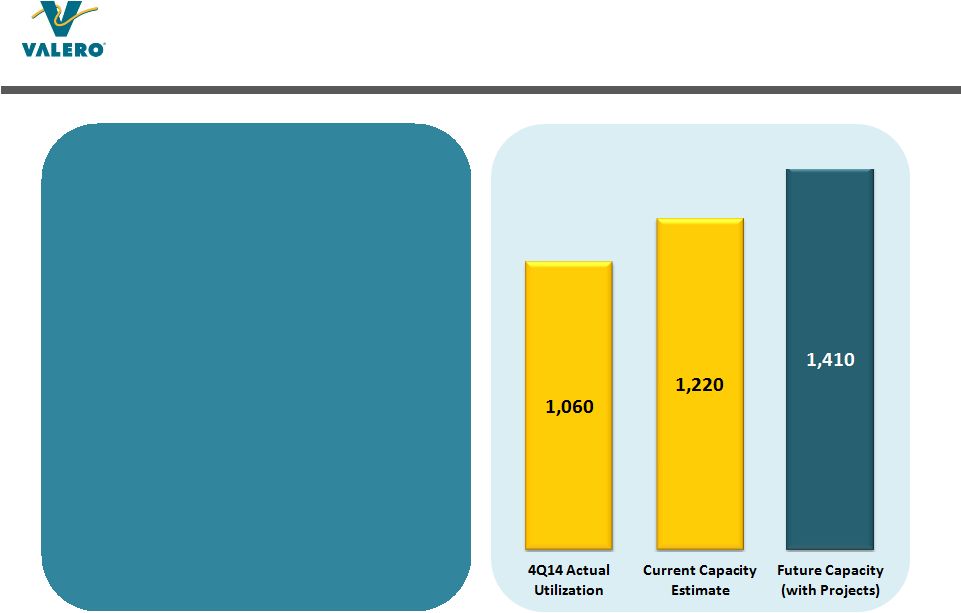 39
Valero’s Light Crude Processing Capacity in
North America
MBPD
(1) Not incentivized in 4Q14 to maximize North American light crude consumption versus
alternative grades.
McKee Crude Unit Expansion
•
25 MBPD additional capacity
expected in 2H15
•
Distillate recovery improvements
Houston Crude Topper
•
90 MBPD capacity expected 1H16
•
Displaces 30 MBPD intermediate
feedstock purchases
Corpus Christi Crude Topper
•
70 MBPD capacity expected 1H16
•
Displaces 25 MBPD intermediate
feedstock purchases
(1) |
 40
Valero Continues to Process Cost-Advantaged
U.S. and Canadian Crude
Note: Non-U.S. and Canadian crude runs exclude Valero’s Pembroke
Refinery. Cost-advantaged crudes exclude imports and historically discounted medium sour crudes, such as Mars/ASCI domestic;
heavy sour crudes, such as Maya; and high-acid crudes, such as Pazflor.
|
 41
Valero Leads Peers in Total Location-
Advantaged Crude Capacity
Source: Company 10-k reports. Crude distillation capacity based on geographic
location. Access to lower cost North American crude benefits refiners in
Mid-Continent, Gulf Coast, and Canada; product export opportunities for Gulf Coast
and Canada |
 42
Expect Quebec City Refinery to Have Cost-Advantaged
Access to 100% North American Crude Slate in 2015
Shifted to cost-advantaged crudes via rail and foreign flagged ships from USGC, with
additional savings expected from deliveries on Enbridge Line 9B beginning in 2Q15
|
 43
U.S. Natural Gas Provides Opex and
Feedstock Cost Advantages
Note: Estimated per barrel cost of 864,000 mmBtu/day of natural gas consumption at 92%
refinery throughput capacity utilization, or 2.7 MMBPD. $1.3 billion
higher pre-tax
annual costs
$2.8 billion
higher pre-tax
annual costs
Valero’s refining operations consume approximately 864,000 mmBtu/day of
natural
gas, split almost equally between operating expense and cost of goods sold
Significant annual pre-tax cost savings compared to refiners in Europe or Asia
|
 44
Valero’s Capacity for Additional
Product Exports
Opportunities to expand U.S. Gulf
Coast export capability for gasoline
to 308 MBPD and diesel to 472
MBPD
Export markets pull volume from
U.S., enabling high refinery
utilization and improved margins
Supported by global refined
products demand growth
Logistics investments also support
segregation |
 Long-Term
Macro Market Expectations Global Outlook
U.S. Economy and
Petroleum Demand
North American
Resource
Advantage
International Export
Markets
•
Economic activity and total petroleum demand increases
•
Transportation fuels demand grows
•
Refining capacity growth slows after 2015; utilization stabilizes then
expected to increase
•
Refinery rationalization pressure continues in Europe, Japan, and Australia
•
Economic growth strengthens over next five years, which stimulates refined
product demand
•
Diesel and jet fuel demand continues to strengthen
•
Gasoline demand continues to recover moderately
•
Natural gas production growth still attractive and development continues
•
Crude production is economic; growth continues, but may be tempered
with lower prices
•
North American refiners maintain competitive advantage
•
Broad lifting of crude export ban not expected for several years, if ever
•
U.S. continues to be an advantaged net exporter of products
•
Atlantic Basin market continues to grow, with increasing demand from
Latin America and Africa
•
U.S. Gulf Coast is strategically positioned with globally competitive assets
45 |
 46
U.S. and Canadian Production Growth Provides
Crude Cost Advantage to North American Refiners
Source: EIA, Consultants, company announcements and Valero estimates; 2014 U.S. Crude imports
as of Nov 2014 Production growth
reduces imports
Largest growth from U.S.
shale crude and heavy
Canadian crude |
 Estimated
Crude Oil Transportation Costs to USEC
Rail $12 to
$15/bbl
to St. James
Rail $12/bbl
to Cushing
Rail $9/bbl
Cushing
to Houston
Pipe $2 to
$4/bbl
Midland
to Houston
Pipe $4/bbl
CC to Houston
$1 to $2/bbl
Houston to
St. James
$1 to $2 /bbl
to West Coast
Rail $13 to $15/bbl
USGC to USEC
U.S. Ship $5 to $7/bbl
USGC to Canada
Foreign Ship $2/bbl
Alberta to Bakken
$1 to $2/bbl
Rail $9/bbl
U.S. Ship
$4 to
$5/bbl
Alberta
to Eastern Canada
Rail $11 to $12/bbl
Bakken
47 |
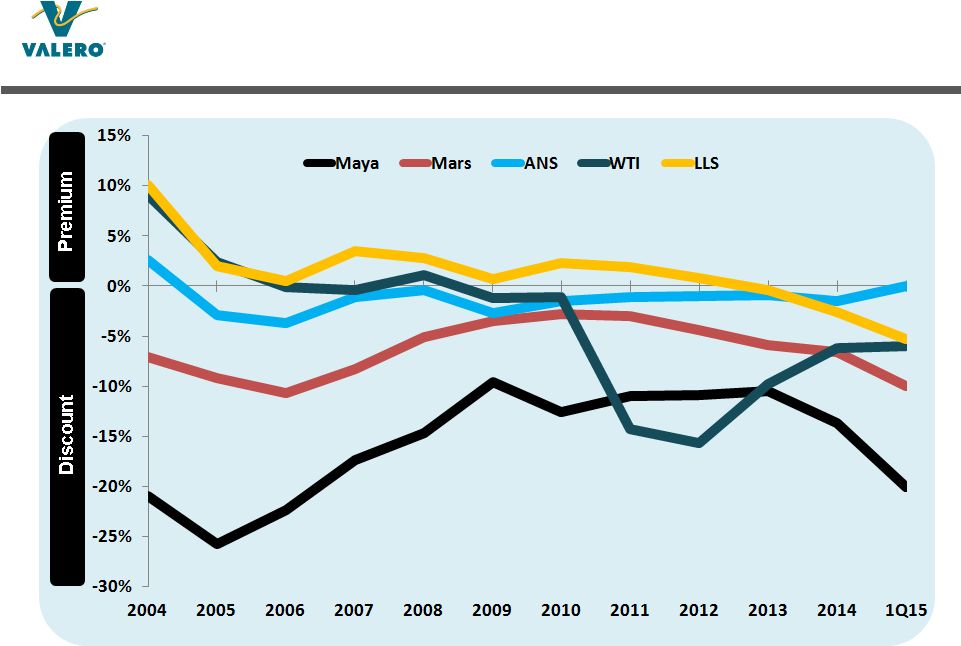 48
Crude Oil Differentials Versus ICE Brent
Source: Argus; 1Q15 through Feb 6. LLS prices are roll adjusted.
|
 49
Valero’s Regional Refinery Indicator Margins
Source: Argus; 1Q15 through Feb 6 |
 •
Gulf Coast Indicator: (GC Colonial 85 CBOB A grade-
LLS) x 60% + (GC ULSD 10ppm
Colonial Pipeline prompt -
LLS) x 40% + (LLS -
Maya Formula Pricing) x 40% + (LLS -
Mars Month 1) x 40%
•
Midcontinent Indicator: [(Group 3 CBOB prompt -
WTI Month 1) x 60% + (Group 3
ULSD 10ppm prompt -
WTI Month 1) x 40%] x 60% + [(GC Colonial 85 CBOB A grade
prompt -
LLS) x 60% + (GC ULSD 10ppm Colonial Pipeline -
LLS) x 40%] x 40%
•
West Coast Indicator: (San Fran CARBOB Gasoline Month 1 -
ANS USWC Month 1) x
60% + (San Fran EPA 10 ppm Diesel pipeline -
ANS USWC Month 1) x 40% + 10%
(ANS –
West Coast High Sulfur Vacuum Gasoil cargo prompt)
•
North Atlantic Indicator: (NYH Conv 87 Gasoline Prompt –
ICE Brent) x 50% + (NYH
ULSD 15 ppm cargo prompt –
ICE Brent) x 50%
•
LLS prices are Month 1, adjusted for complex roll
•
Prior to 2010, GC Colonial 85 CBOB is substituted for GC 87 Conventional
•
Prior to 4Q13, Group 3 Conventional 87 gasoline substituted for Group 3 CBOB
50
Valero’s Regional Indicator Margins Defined |
 Low Cost U.S.
Natural Gas Provides Competitive Advantage
51
Sources:
Argusand
Bloomberg.
Japan
LNG
through
Nov
30,
2014;
U.S.
and
Europe
through
Feb
12,2015.
Natural
gas
price
converted
to
barrels
using
factor
of
6.05x
•
U.S. natural gas is significantly discounted to Brent on an energy equivalent basis
•
Prices expected to remain low and disconnected from global oil and gas markets
for foreseeable future |
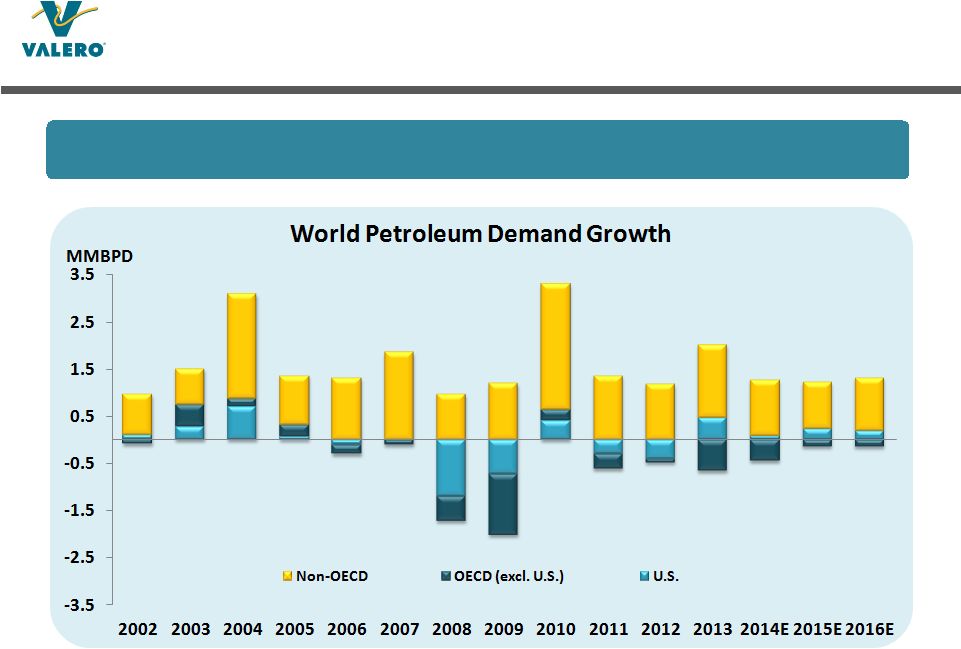 52
Global Petroleum Demand Projected to Grow
Source: Consultant (EIA and IEA) and Valero estimates. Consultant annual estimates
generally updated 6 to 12 months after year end. Emerging markets in Latin
America, Middle East, Africa, and Asia lead demand growth
|
 53
U.S. Refining Capacity Is Globally Competitive and
Continues to Take Market Share
Source: EIA and IEA (U.S. data through November 2014, Europe data through December
2014) Less-competitive capacity
Source: EIA (2014 data through November)
Net imports
Net
exports
•
U.S. flipped from importer to exporter on lower local product demand and higher refinery
utilization, particularly in PADDS 2, 3, and 4, driven by structural cost advantages
for crude oil and natural gas
•
Gulf Coast refineries have gained export market share in the Atlantic Basin
|
 54
World Refinery Capacity Growth
Source:
Consultantand
Valero
estimates;
Net
Global
Refinery
Additions
=
New
Capacity
+
Restarts
–
Announced
Closures
•
New capacity additions expected in Asia and Middle East
•
Announced new capacity in Brazil, Mexico, and Colombia likely to
be smaller and start later than
planned
•
Expansions in Ecuador, Peru, Algeria, and Egypt unlikely due to cost and geopolitical
pressures •
Capacity rationalization expected to continue in Europe, Australia, and Japan
|
 55
Capacity Rationalization in Atlantic Basin
Sources: Industry and Consultant reports and Valero estimates
•
Marginal refiners in U.S. East Coast, Caribbean and Western Europe are shutting capacity
•
Demand growth, poor reliability, and low utilization in Latin American refineries provide
opportunities for competitive refineries to export products and meet supply needs
|
 *Partial
closure of refinery captured in capacity. Note: This data represents refineries currently closed, ownership may choose to restart or sell listed refinery.
Sources:
Industry
and
Consultant
reports,
Valero
estimates,
and
direct
and
public
disclosure
by
each
owner.
Location
Owner
CDU Capacity
Closed (MBPD)
Year
Closed
Location
Owner
CDU Capacity
Closed (MBPD)
Year
Closed
Perth Amboy, NJ
Chevron
80
2008
Coryton, U.K.
Petroplus
175
2012
Bakersfield,CA
Big West
65
2008
Petit Couronne, France
Petroplus
160
2012
Ingolstadt, Germany*
Bayernoil
102
2008
Rome, Italy
Total/Erg
88
2012
Yabucoa, Puerto Rico
Shell
76
2008
Fawley, U.K.*
ExxonMobil
80
2012
Westville, NJ
Sunoco
145
2009
Paramo, Czech Republic
Unipetrol
20
2012
Bloomfield, NM
Western
17
2009
St. Croix, U.S.V.I
Hovensa
350
2012
North Pole, AK*
Flint Hills
85
2009
Aruba
Valero
235
2012
Teesside, UK
Petroplus
117
2009
Lisichansk, Ukraine
TNK-BP
175
2012
Gonfreville, France*
Total
90
2009
Clyde, Australia
Shell
75
2012
Dunkirk, France
Total
140
2009
Port Reading, NJ
Hess
N/A
2013
Toyama, Japan
Nihonkai Oil
57
2009
Dartmouth, Canada
Imperial Oil
88
2013
Yorktown, VA
Western
65
2010
Harburg, Germany
Shell
107
2013
Montreal, Canada
Shell
130
2010
Porto Marghera, Italy
ENI
80
2013
Reichstett, France
Petroplus
85
2010
Sakaide, Japan
Cosmo Oil
140
2013
Wilhemshaven, Germany
ConocoPhillips
260
2010
North Pole, AK
Flint Hills
80
2014
Sodegaura, Japan*
Fuji Oil
50
2010
Mantova, Italy
MOL
69
2014
Oita, Japan*
JX Holdings
24
2010
Stanlow, U.K.*
Essar
101
2014
Mizushima, Japan*
JX Holdings
110
2010
Milford Haven, UK
Murphy
130
2014
Negishi, Japan*
JX Holdings
70
2010
Yokkaichi, Japan*
Cosmo Oil
43
2014
Kashima, Japan*
JX Holdings
18
2010
Tokuyama, Japan
Idemitsu Kosan
114
2014
Marcus Hook, PA
Sunoco
175
2011
Kurnell, Australia
Caltex
135
2014
St. Croix, U.S.V.I,*
Hovensa
150
2011
Kawasaki, Japan *
Tonen-General
67
2014
Arpechim, Romania
OMV Petrom
70
2011
Wakayama, Japan*
Tonen-General
38
2014
Cremona, Italy
Tamoil
94
2011
Muroran, Japan
JX Holdings
180
2014
Ogimachi, Japan
Toa Oil Company
120
2011
Chiba, Japan*
Kyokuto Petroleum
23
2014
Funshun, China
Funshun Petrochem.
70
2011
Kaohsiung, Taiwan
Chinese Petroleum Corp.
200
2015
Paramount, CA
Alon
90
2012
Bulwer Island, Australia
BP
102
2015
North Pole, AK*
Flint Hills
48
2012
Lindsey, U.K.*
Total
110
2016
Berre L’Etang, France
LyondellBasell
105
2012
56
Global Refining Capacity Rationalization |
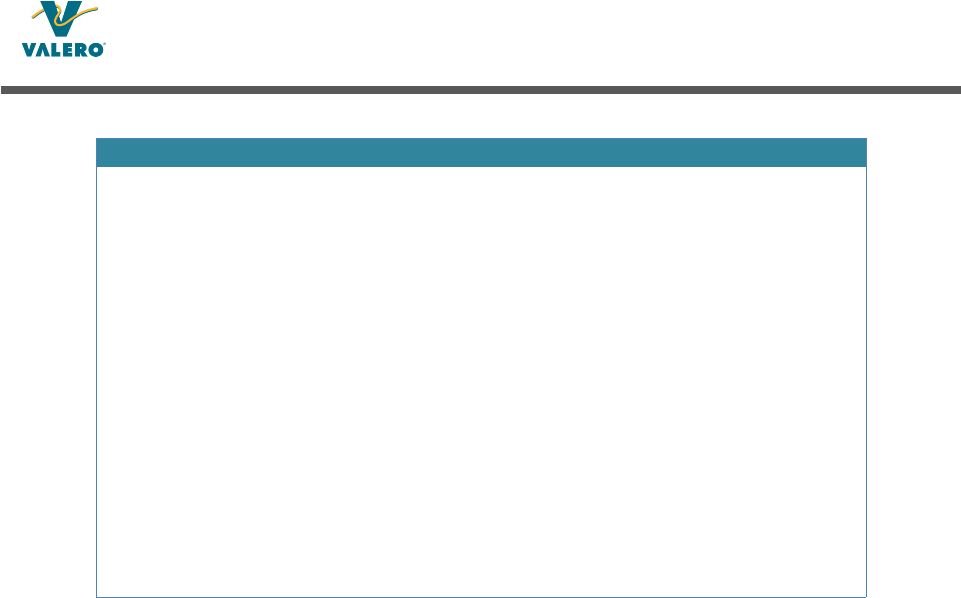 Location
Owner
CDU Capacity (MBPD)
Lytton, Australia
Caltex
109
Nishihara, Japan
Petrobras/Sumitomo
95
Inchon, Korea
SK Energy
270
Whitegate, Ireland
Phillips 66
71
Barbers Point, HI
Chevron
54
Pasadena, TX
Petrobras
100
Bahia Blanca, Argentina
Petrobras
31
Gothenburg, Sweden
Shell
80
Port Dickson, Malaysia
Shell
156
Livorno
ENI
106
Taranto
ENI
120
Mazeikiai, Lithuania
PKN
190
Okinawa, Japan
Petrobras/Nansei Sekiyu
100
Falconara, Italy
API
80
Hamburg, Germany
Tamoil
78
Collombey, Switzerland
Tamoil
72
Chiba, Japan
Cosmo Oil
240
Chiba, Japan
TonenGeneral
152
57
Global Refining Capacity For Sale or Under
Strategic Review
Sources: Direct and public disclosure by each owner |
 58
U.S. Crude Fundamentals
Source: DOE weekly data through February 6, 2015 |
 59
U.S. Gasoline Fundamentals
USGC Brent Gasoline Crack (per bbl)
U.S. Gasoline Demand (mmbpd)
Source: Argus; 2015 weekly data through Feb 6
Source: 2014 DOE monthly data through Nov 2014; 2015 weekly data through Feb 6
Source: 2014 DOE monthly data through Nov 2014; 2015 weekly data through Feb 6
U.S. Net Imports of Gasoline and Blendstocks (mbpd)
Source: 2014 DOE monthly data through Nov 2014
U.S. Gasoline Days of Supply |
 60
U.S. Distillate Fundamentals
USGC Brent ULSD Crack (per bbl)
U.S. Distillate Demand (mmbpd)
Source: Argus; 2015 weekly data through Feb 6
Source: 2014 DOE monthly data through Nov 2014; 2015 weekly data through Feb 6
Source: 2014 DOE monthly data through Nov 2014; 2015 weekly data through Feb 6
Source: 2014 DOE monthly data through Nov 2014; 2015 weekly data through Feb 6
U.S. Distillate Days of Supply
U.S. Distillate Net Imports (mbpd) |
 61
U.S. Transport Indicators
Source: U.S. DOE PSM / U.S. DOT FHA
Most recent data includes Nov 2014 |
 62
U.S. Transport Indicators: Trucking |
 Note:
Gasoline represents all finished gasoline plus all blendstocks (including ethanol, MTBE, and other oxygenates)
Source: DOE Petroleum Supply Monthly data as of November 2014.
4 Week Average estimate from Weekly Petroleum Statistics Report and Valero estimates.
63
Increase in U.S. Gasoline Exports |
 Decrease in
U.S. Gasoline Imports Note: Gasoline represents all finished gasoline plus all
blendstocks (including ethanol, MTBE, and other oxygenates) Source:
DOE
Petroleum
Supply
Monthly
data
as
of
November
2014.
4
Week
Average
estimate
fromWeekly
Petroleum
Statistics
Report
and
Valero
estimates.
64 |
 Source: DOE
Petroleum Supply Monthly with data as of November 2014. 4 Week Average estimate from Weekly Petroleum Statistics Report
65
Increase in U.S. Diesel Exports
12 Month Moving Average, MBPD |
 66
U.S. Is Net Refined Products Exporter
U.S. Demand for Refined Products and Net Trade
MMBPD
U.S. Petroleum Demand Excluding Ethanol and Non-Refinery NGL’s
(Refined Product Demand)
Net Imports
Net
Exports
Implied Total Production of
U.S. Refined Products
Note:
Implied
production
=
Petroleum
demand
excluding
ethanol
and
non-refinery
NGLs
minus
product
netimports.
Source:
EIA,
Consultant
and
Valero
estimates;
data
through
Nov
2014
Implied Production of U.S. Refined
Products for Domestic Use
Valero’s share of U.S. exports has averaged 20% to 25% over the past few years
|
 MBPD
67
U.S. Shifted to Net Exporter
Note: Gasoline represents all finished gasoline plus all blendstocks (including ethanol,
MTBE, and other oxygenates) Source: DOE Petroleum Supply Monthly data as of Nov
2014 •
Net refined products exports increased from 335 MBPD in 2010 to 2,450 MBPD in 2014
•
Diesel net exports averaged 917 MBPD in 2014 (Jan-Nov)
•
Gasoline net exports averaged 50 MBPD in 2014 (Jan –
Nov)
•
Gasoline and blendstocks have shifted to net exports |
 Source:
DOE
Petroleum
Supply
Monthly
dataas
of
Nov2014;
Latin
America
includes
Southand
Central
America
plus
Mexico.
U. S. Product Exports By Destination
U. S. Product Exports By Source
MMBPD
12 Month Moving Average
68
U.S. Growing Market Share by Exports
•
Refined products demand is growing in developing countries and Atlantic Basin
(capacity closures)
•
U.S. Gulf Coast (PADD III) is the largest source of exported products
|
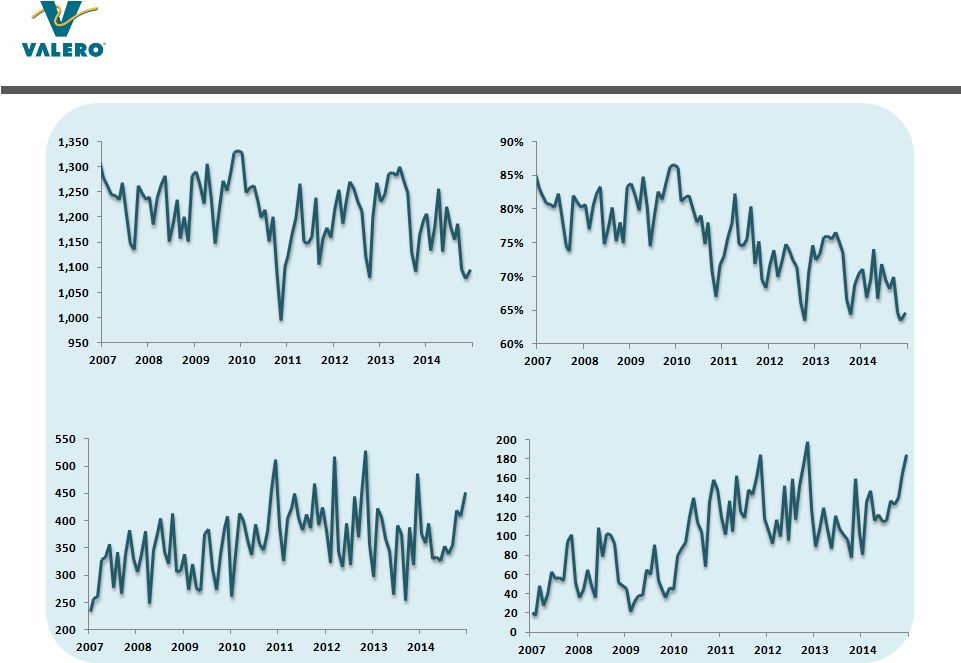 69
Mexico Statistics
Diesel Gross Imports (MBPD)
Source: PEMEX, latest data Dec 2014
Gasoline Gross Imports (MBPD)
Crude Unit Throughput (MBPD)
Crude Unit Utilization |
 70
Decrease in Venezuelan Exports to the U.S.
Source: EIA, November 2014 |
 71
Reconciliation of Operating Income to EBITDA
Ethanol (millions)
2Q09 –
4Q09
2010
2011
2012
2013
2014
Cumulative
Operating income
$165
$209
$396
$(47)
$491
$786
$2,000
+ Depreciation and
amortization expense
$18
$36
$39
$42
$45
$49
$229
= EBITDA
$183
$245
$435
$(5)
$536
$835
$2,229 |
 Investor
Relations Contacts 72
For more information, please contact:
John Locke
Executive Director, Investor Relations
210-345-3077
john.locke@valero.com
Karen Ngo
Manager, Investor Relations
210-345-4574
karen.ngo@valero.com |
